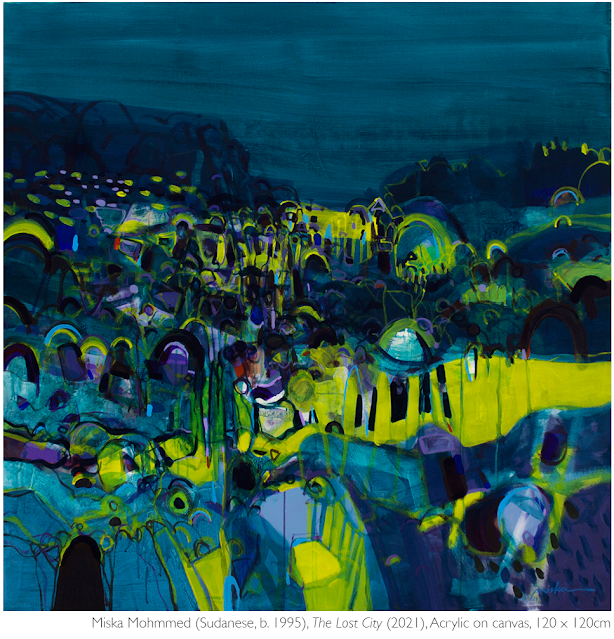MISKA’S MAGICAL REALISM PAINTS RIVER NILE IN NEW LIGHT
By Margaretta wa Gacheru
When Circle Art Gallery held its
first Khartoum Contemporary exhibition back in 2017, Miska Mohmmed was not just
the only woman whose are was in the show. She was also the youngest artist
among them. But she wasn’t too young to make a deep impression on Circle
audiences who responded well to her River Nile-inspired art.
Miska’s paintings has been exhibited
by Circle Art several times since then, but not only in Nairobi. Circle Art’s
founder and director Danda Jamoljmek has taken her work all the way to Lagos
and in October she will take it to London for another Art Fair there. Danda has
also included the 26 year old painter in two of the last Art Auctions East
Africa.
Currently, Miska is here in Nairobi
to attend her first solo exhibition at Circle Art which will run at the gallery
until October 8th. Speaking to BD Life, she explains how growing up
close to the Nile has had a profound impression on her art. One can easily see
it in her luminous paintings which are suffused with luscious colors, hues of
deep blues and shadowy blacks as well as grassy spring greens.
She paints like an oceanic alchemist,
blending colors into a magical mix that conjure up ‘forgotten places” which
emerge out of the depths of Miska’s vivid imagination.
Miska admits her connection with the
Nile runs deep. “When I’m at home, I climb up to my third-floor studio where I
can see the Nile from my window. It always inspires me,” she says.
Mainly painting semi-abstract
landscapes and seascapes in acrylics on canvas, Miska is meticulous about first
sketching out her ideas in watercolor works which are equally elegant and rich
in a similar palette.
Describing herself as a landscape
artist, Miska says her art is not about specific people or places. “My art is
more about my feelings and the energy that I pick up from the places where I am
painting,” says the artist who loves painting in the open air.
Those feelings are best expressed in
river scenes where her waters are either swirling or free flowing, choppy or
tranquil. She occasionally accentuates the beauty of her water worlds with
lotus or daisies, rather reminiscent of Claude Monet’s Water Lilies.
Miska even paints an entire ‘lost
city’ underwater with as many byways and highways as one can almost see in her
exceptional ‘Crowded Town’. This work is exceptional for several reasons. For
one, it’s her only cityscapes in the show. It’s also the only one where she
changes her palette radically with streets painted fire engine red. The glaring
reds seem to register the emotional cacophony that Miska hears in her head, but
which inspired her all the same to paint this busy city that also engaged her
attention.
A graduate with a Bachelor of Fine
Arts in 2016 from the Sudan University’s College of Fine and Applied Arts,
Miska says she was blessed with parents who encouraged her to paint from a very
early age. “They are not artists themselves but they love art and encouraged me
to be creative,” she says.
That kind of family support meant
that Miska started early to cultivate her artistic talents such that today, her
art is already earning her significant figures. For instance, on the opening
day of her exhibition, “The Magic of Forgotten Places” several of her large
paintings were sold on the spot. Among those that sold was Tranquility for
USD4,200 and The Lost City for USD2,900. So Kenyan parents need to understand
their children can be successful as artists, not just lawyer, accountants, and
doctors, when they are encouraged and inspired to express themselves.
Miska says she only knows one other
female artist from Sudan. She says Kamala Shug is still alive and painting, and
she has inspired Miska to continue advancing with her art. Miska hopes she can
also inspire other young women artists by her example.





























